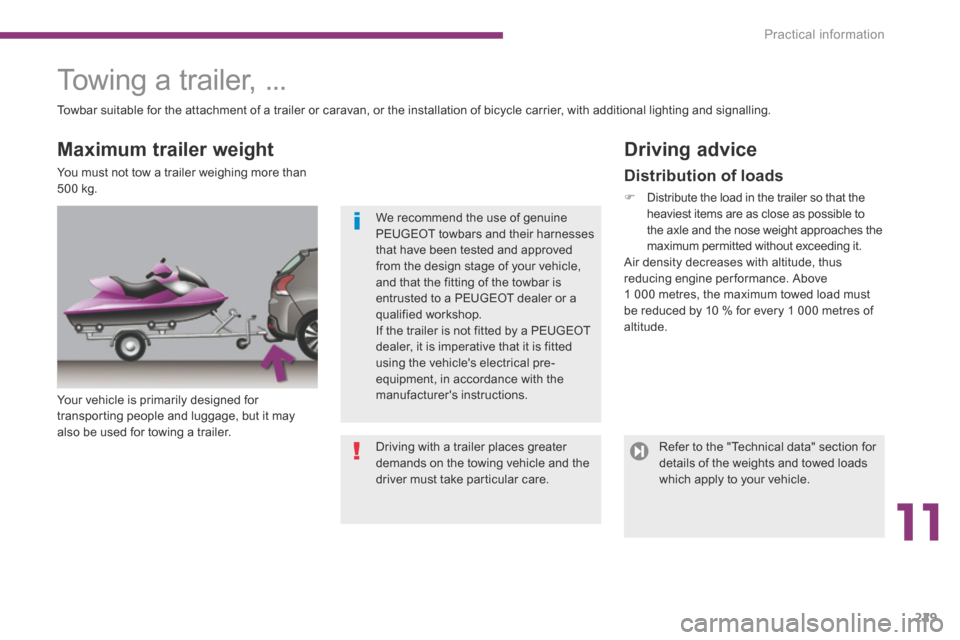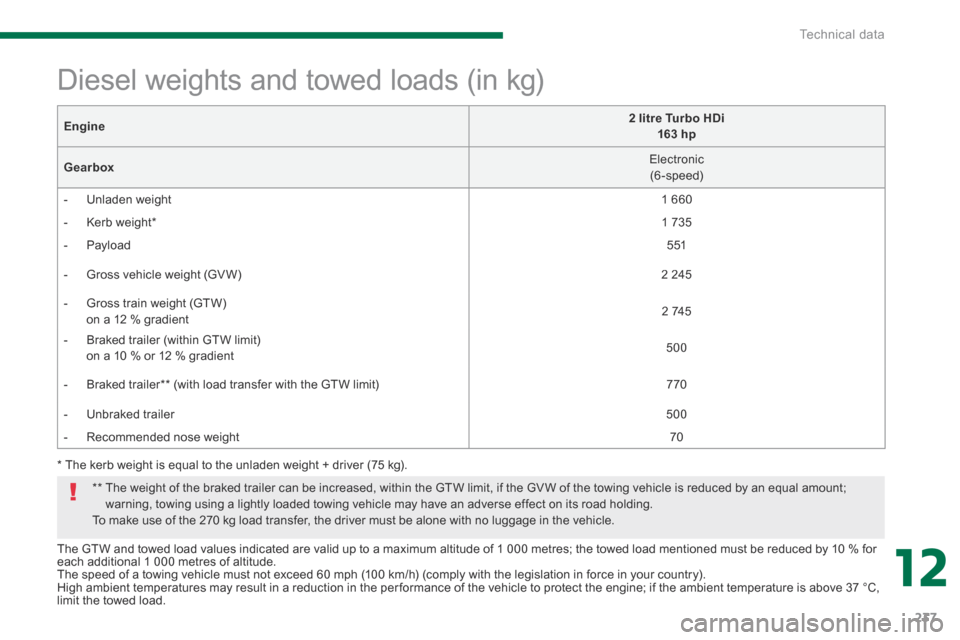Page 212 of 378
Practical information
210
Changing main beam headlamp bulbs
(halogen model)
Remove the protective plastic cover by pulling the tab. Without disconnecting the connector, turn the body of the bulb a quarter of a turn to the left to disengage the assembly. Disconnect the connector to release the bulb. To refit, carry out these operations in reverse
o r d e r.
Changing dipped beam headlamp bulbs (models with halogen headlamps)
Remove the protective plastic cover by pulling the tab. Disconnect the bulb connector. Extract the bulb by pulling and change it. To refit, carry out these operations in reverse o r d e r.
Changing direction indicators and daytime running lamps / sidelamps
For the replacement of these LED (light-emitting diode) lamps, contact a PEUGEOT dealer or a qualified workshop.
Page 214 of 378
Practical information
212
Rear lamps
1. Brake lamps / sidelamps (light - emitting diodes - LEDs). 2. Reversing lamps (W16W).3. Direction indicators (P21W).4.S idelamps (light-emitting diodes - LEDs).5. Foglamps (P21W).
Changing reversing lamp and direction indicator bulbs
Raise the tailgate. Remove the plastic cover. Unscrew the two fixing nuts. Extract the lamp unit carefully from the outside. Disconnect the bulb holder connector.
- Turn the the lamp unit over. - Press the five tabs and remove the bulb h o l d e r.
- Reversing lamp (2) : pull on the bulb to
remove it. - Direction indicator (3) : turn the bulb a quarter of a turn (anti-clockwise) to remove it.
To refit, carry out these operations in reverse o r d e r.
Page 215 of 378
11
Practical information213
Changing the third brake lamp (light emitting diodes - LEDs)
Changing sidelamp and brake lamp/sidelamp bulbs Changing foglamp bulbs
For the replacement of these LED (light-emitting diode) lamps, contact a PEUGEOT dealer or a qualified workshop.
Reach under the bumper. Turn the bulb a quarter of a turn and pull it out.
Contact a PEUGEOT dealer or a qualified workshop.
Changing the number plate lamp bulbs (W5W)
Insert a thin screwdriver into one of the outer holes of the lens. Push it outwards to unclip. Remove the lens. Pull the bulb out and change it.
Page 217 of 378
11
Practical information215
Dashboard fuses Fuse tables
The fusebox is placed in the lower dashboard.
Fuse N° Rating (A) Functions
F115 Rear wiper.
F2- Not used.
F35 Airbag control unit.
F410 Electrochrome rear view mirror, air conditioning, switching and protection unit, rear multimedia, traction battery control unit.
F530 Front one-touch electric windows.
F630 Rear one-touch electric windows.
F75 Front and rear courtesy lamps, map reading lamps, rear reading lamps, sun visor lighting, glove box lighting, centre armrest lighting, boot 12 V relay control.
Page 218 of 378
Practical information
216
Access to the fuses
See "Access to the tools". Fuse N° Rating (A) Functions
F820 Audio equipment, audio/telephone, CD changer, multifunction screen, tyre under-inflation detection, alarm siren, alarm control unit, telematic unit.
F930 Front 12 V socket, cigarette lighter, rear 12 V socket.
F1015 Steering mounted controls.
F1115 Low current ignition switch.
F1215 Trailer presence, rain / sunshine sensor, supply for fuses F32, F34, F35.
F135 Engine fusebox, airbag control unit.
F1415 Instrument panel, instrument panel screen, supply for fuse F33.
F1530 Locking and deadlocking.
F1740 Heated rear screen, supply for fuse F30.
Page 231 of 378

11
Practical information229
Towing a trailer, ...
Your vehicle is primarily designed for transporting people and luggage, but it may also be used for towing a trailer.
Driving advice Maximum trailer weight
You must not tow a trailer weighing more than 500 kg. Distribution of loads
Distribute the load in the trailer so that the heaviest items are as close as possible to the axle and the nose weight approaches the maximum permitted without exceeding it. Air density decreases with altitude, thus reducing engine performance. Above 1 000 metres, the maximum towed load must be reduced by 10 % for every 1 000 metres of altitude.
Towbar suitable for the attachment of a trailer or caravan, or the installation of bicycle carrier, with additional lighting and signalling.
Driving with a trailer places greater demands on the towing vehicle and the driver must take particular care.
We recommend the use of genuine
PEUGEOT towbars and their harnesses that have been tested and approved from the design stage of your vehicle, and that the fitting of the towbar is entrusted to a PEUGEOT dealer or a qualified workshop. If the trailer is not fitted by a PEUGEOT dealer, it is imperative that it is fitted using the vehicle's electrical pre-equipment, in accordance with the manufacturer's instructions.
Refer to the "Technical data" section for details of the weights and towed loads which apply to your vehicle.
Page 232 of 378
Practical information
230
Cooling
Towing a trailer on a slope increases the temperature of the coolant. As the fan is electrically controlled, its cooling capacity is not dependent on the engine speed. To lower the engine speed, reduce your speed. The maximum towed load on a long incline depends on the gradient and the ambient temperature. In all cases, keep a check on the coolant temperature.
Side wind
Take into account the increased sensitivity to side wind.
Ty r e s
Check the tyre pressures of the towing vehicle and of the trailer, observing the recommended pressures.
Braking
Towing a trailer increases the braking distance.
If the warning lamp and the STOP warning lamp come on, stop the vehicle and switch off the engine as soon as possible.
Lighting
Check the electrical lighting and signalling on the trailer.
The rear parking sensors will be deactivated automatically if a genuine PEUGEOT towbar is used.
Page 239 of 378

12
Technical data237
The GTW and towed load values indicated are valid up to a maximum altitude of 1 000 metres; the towed load mentioned must be reduced by 10 % for each additional 1 000 metres of altitude. The speed of a towing vehicle must not exceed 60 mph (100 km/h) (comply with the legislation in force in your country). High ambient temperatures may result in a reduction in the per formance of the vehicle to protect the engine; if the ambient temperature is above 37 °C, limit the towed load.
Diesel weights and towed loads (in kg)
* The kerb weight is equal to the unladen weight + driver (75 kg).
Engine2 litre Turbo HDi 163 hp
Gearbox Electronic (6-speed)
- Unladen weight 1 6 6 0
- Kerb weight * 1 7 3 5
- Payload 5 5 1
- Gross vehicle weight (GV W) 2 2 4 5
- Gross train weight (GTW) on a 12 % gradient 2 7 4 5
- Braked trailer (within GTW limit) on a 10 % or 12 % gradient 5 0 0
- Braked trailer ** (with load transfer with the GTW limit) 7 7 0
- Unbraked trailer 5 0 0
- Recommended nose weight 7 0
** The weight of the braked trailer can be increased, within the GTW limit, if the GV W of the towing vehicle is reduced by an equal amount; warning, towing using a lightly loaded towing vehicle may have an adverse effect on its road holding. To make use of the 270 kg load transfer, the driver must be alone with no luggage in the vehicle.